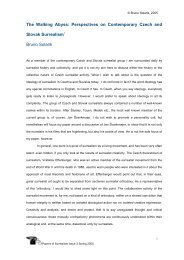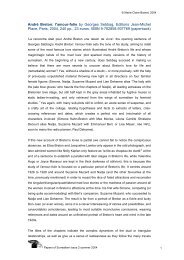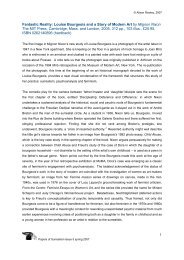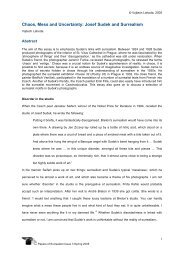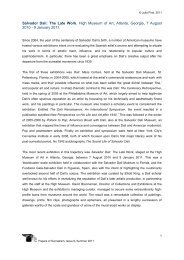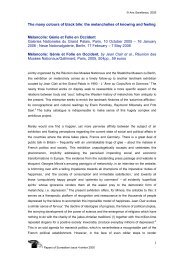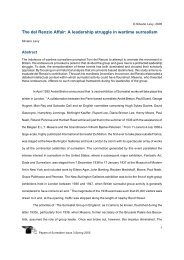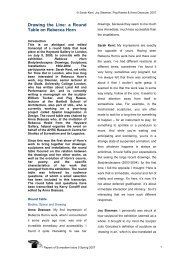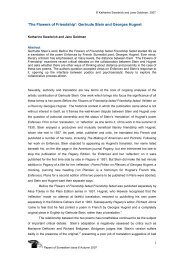From the Walls of Factories to the Poetry of the Street: Inscriptions ...
From the Walls of Factories to the Poetry of the Street: Inscriptions ...
From the Walls of Factories to the Poetry of the Street: Inscriptions ...
Create successful ePaper yourself
Turn your PDF publications into a flip-book with our unique Google optimized e-Paper software.
© Caroline Levitt, 2011<br />
Official monumental sculpture was scorned by both Apollinaire and <strong>the</strong> surrealists. Writing on<br />
Raymond Duchamp-Villon (and on <strong>the</strong> relationship between sculpture and architecture) in Les<br />
Peintres cubistes (1913), Apollinaire noted that „<strong>the</strong> whole world is covered with monuments more or<br />
less devoid <strong>of</strong> any practical purpose.‟ 38 One function <strong>of</strong> monuments is <strong>to</strong> promote veneration, and<br />
traditional monumental sculpture or memorials are optimistic in <strong>the</strong>ir nature (anti-naturalist),<br />
representing <strong>the</strong> idealised qualities <strong>of</strong> <strong>the</strong>ir subject ra<strong>the</strong>r than <strong>the</strong>ir humanity. When monuments<br />
become so prolific, <strong>the</strong>n, <strong>the</strong>y become commonplace, and thus <strong>the</strong>ir purpose <strong>of</strong> standing out <strong>to</strong> mark<br />
something extraordinary is undermined. When <strong>the</strong> Oiseau de Bénin (<strong>the</strong> Bird <strong>of</strong> Benin), <strong>the</strong> character<br />
representing Picasso in Apollinaire‟s au<strong>to</strong>biographical roman à clef „Le Poète assasiné‟ (1916) speaks<br />
<strong>of</strong> <strong>the</strong> monument he will erect <strong>to</strong> his poet friend, it is not a marble or bronze allegory, but „a pr<strong>of</strong>ound<br />
statue made <strong>of</strong> nothing, like poetry and like glory.‟ 39 Ornamentation and large scale, two <strong>of</strong> <strong>the</strong><br />
characteristics that make typical <strong>of</strong>ficial monuments so noticeable, stand in direct opposition <strong>to</strong> <strong>the</strong><br />
small scale and aes<strong>the</strong>tic banality <strong>of</strong> <strong>the</strong> personal ephemera discussed so far in relation <strong>to</strong> Apollinaire,<br />
and <strong>to</strong> his idea <strong>of</strong> <strong>the</strong> perfect memorial.<br />
However for Bre<strong>to</strong>n, <strong>to</strong>o, <strong>the</strong> personal ephemera within Paris is <strong>of</strong> far greater importance than<br />
<strong>the</strong> city‟s famous buildings and vistas. Bre<strong>to</strong>n comments in Nadja that not even „la très belle et très<br />
inutile Porte S. Denis‟ (<strong>the</strong> very beautiful and very useless Porte St. Denis), again a monument at <strong>the</strong><br />
edge <strong>of</strong> Paris, could properly explain his attraction <strong>to</strong> that area <strong>of</strong> <strong>the</strong> city. He illustrates his comment<br />
with a pho<strong>to</strong>graph <strong>of</strong> <strong>the</strong> Porte S. Denis, demonstrating <strong>the</strong> futility both <strong>of</strong> a gateway that stands alone<br />
with no city wall through which it might serve as a thoroughfare, and <strong>of</strong> elaborate decoration that is<br />
meaningless <strong>to</strong> <strong>the</strong> inhabitants <strong>of</strong> modern Paris and which cars and passers-by ignore. 40 The<br />
gateway‟s lack <strong>of</strong> function does not seem <strong>to</strong> pose a particular problem <strong>to</strong> Bre<strong>to</strong>n (nor would one<br />
expect it <strong>to</strong>, given his fascination with <strong>the</strong> dysfunctional and outmoded), ra<strong>the</strong>r <strong>the</strong> point is that he is<br />
puzzled by <strong>the</strong> way he is drawn <strong>to</strong> <strong>the</strong> area, and <strong>the</strong> monument provides no explanation. Indeed,<br />
Nadja is a novel in which <strong>of</strong>ficial Paris is consistently overwritten by a highly personalised view <strong>of</strong> <strong>the</strong><br />
city.<br />
As Simon Baker has noted, Bre<strong>to</strong>n begins his walk through Paris in Nadja facing <strong>the</strong> hôtel<br />
des Grands Hommes, where he had lived for almost two years between September 1918 and <strong>the</strong><br />
Summer <strong>of</strong> 1920, and thus consequently with his back <strong>to</strong> that greatest <strong>of</strong> all humanist monuments: <strong>the</strong><br />
Panthéon. 41 The pho<strong>to</strong>graph included <strong>to</strong> illustrate this section <strong>of</strong> <strong>the</strong> narrative is taken, appropriately,<br />
from inside <strong>the</strong> railings that surround <strong>the</strong> Panthéon, facing outwards. 42 Elsewhere, <strong>the</strong> St Ouen flea<br />
market, <strong>the</strong> Sphinx Hotel and a luminous Mazda sign are what will pho<strong>to</strong>graphically „remain‟ <strong>of</strong> Bre<strong>to</strong>n<br />
and Nadja, although <strong>the</strong> text itself is set up equally as a remnant <strong>of</strong> <strong>the</strong>ir relationship. As Nadja had<br />
put it, „everything fades, everything vanishes. Something must remain <strong>of</strong> us.‟ 43 What remains <strong>of</strong><br />
individuals, in <strong>the</strong> case <strong>of</strong> Nadja a retrospective account <strong>of</strong> an encounter that might o<strong>the</strong>rwise have<br />
proved insignificant, is fundamental <strong>to</strong> <strong>the</strong> concept <strong>of</strong> <strong>the</strong> monument and, according <strong>to</strong> Brassaï‟s poem<br />
cited earlier, <strong>to</strong> graffiti.<br />
If Bre<strong>to</strong>n‟s Nadja included pho<strong>to</strong>graphs from <strong>the</strong> outset, it was not until 1926 that Apollinaire‟s<br />
„Le Poète assassiné‟ was illustrated with a series <strong>of</strong> lithographs by Raoul Dufy; four hundred and<br />
seventy illustrated copies were published by Les Éditions Au Sans Pareil. The release <strong>of</strong> Dufy‟s<br />
Papers <strong>of</strong> Surrealism, Issue 9, Summer 2011 11





